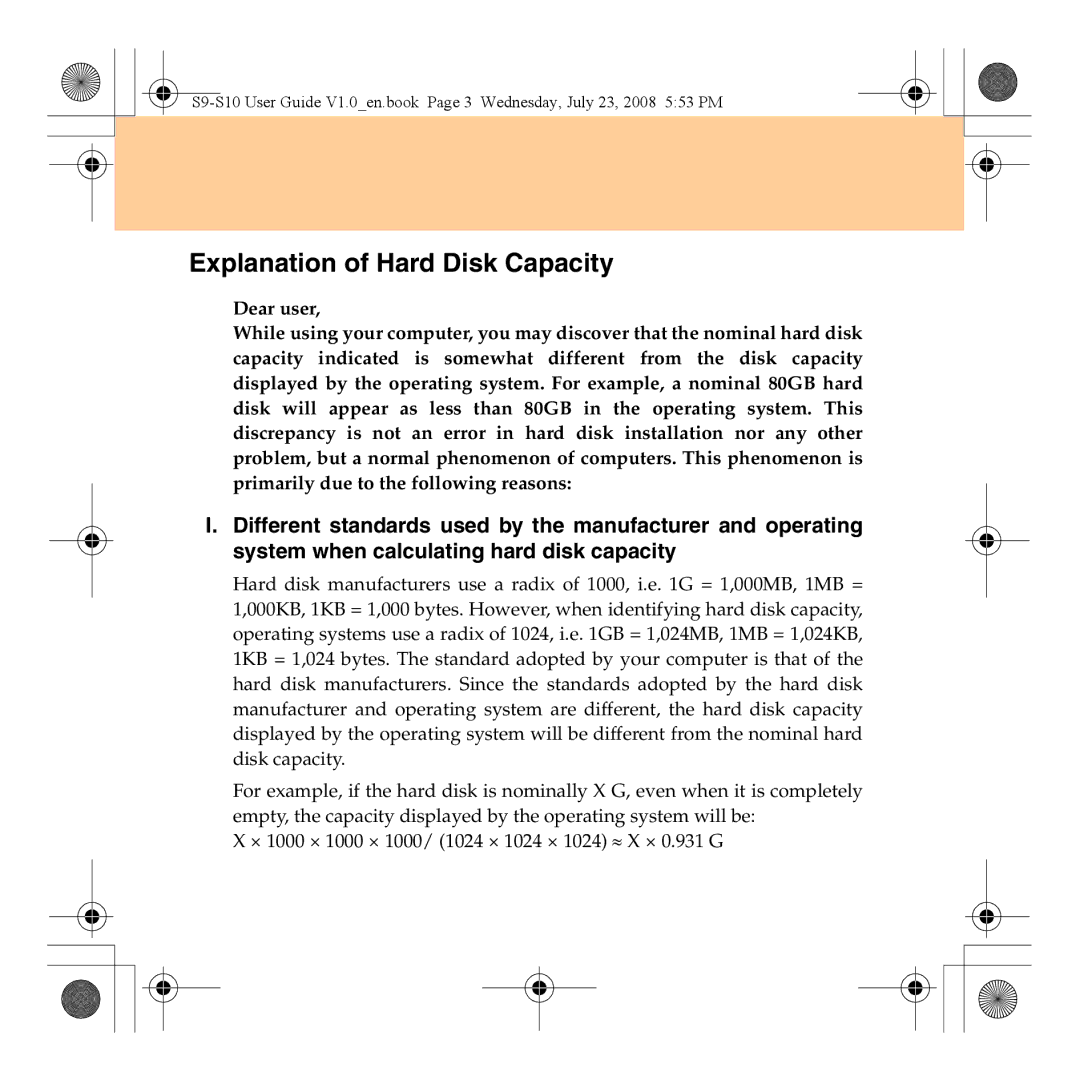Lenovo IdeaPad S9/S10
S9/S10 User Guide V1.0 EN cover2-3
If your product is not working correctly
Energy Star model information
Page
Explanation of Hard Disk Capacity
Page
Contents
Appendix B. Customer
Contents Appendix A. Lenovo Limited
100
102
Top View
Getting to Know Your Computer
Wireless device switch
Power button
Getting to Know Your Computer Computer display
Microphone built-in
Left-side View
AC power adapter jack
Getting to Know Your Computer
Fan louvers
Security keyhole
Right-side View
Speakers
System status indicators
Front View
Bottom View
Battery latch manual
Getting to Know Your Computer Battery latch spring loaded
ƒ Hard Disk Drive
„ Shutting Down Your computer
Using Your Computer
„ Putting your computer to Stand By
Using Your Computer
Using the Touch Pad
„ Numeric Keypad
Using the Keyboard
„ Function Key Combinations
Using Your Computer
„ OneKey Rescue System button
Using memory cards
„ Removing a memory card
Using the Integrated Camera
„ Inserting a memory card
„ Using LAN port
Using the Internet
„ Using wireless LAN
Securing your computer
„ Using Passwords
To set a Supervisor Password
Select Set Supervisor Password, and press the Enter key
Changing or Removing the User Password
Using Your Computer To set a User Password
Using Your Computer
„ Your Computer Batteries
Using battery and AC adapter
Installing Device Drivers
„ Using the AC Adapter
„ Checking Battery Status
Using Your Computer
„ Handling the Battery
„ Charging the Battery
Using Your Computer
Connecting a Universal Serial Bus USB device
Using external devices
Using external devices
Connecting a PC card device
„ Connecting a VGA monitor
Connecting an external display
Connecting a headphone and audio device
Connecting an external microphone
„ Enabling Bluetooth communications
Connecting a Bluetooth device
Frequently Asked Questions
Troubleshooting
Where are the recovery discs?
Troubleshooting
When I turn on the computer, nothing appears on the screen
Troubleshooting
„ Display Problems
My screen goes blank while the computer is on
„ Keyboard Problems
„ a Password Problem
Forgot my password
Number appears when you enter a letter
Computer enters sleep mode unexpectedly
„ Sleep or Hibernation Problems
Screen is blank
„ Computer Screen Problems
Click the Advanced Settings button
Troubleshooting Screen is unreadable or distorted
Troubleshooting Incorrect characters appear on the screen
Operating time for a fully charged battery is short
„ Sound Problems
„ Battery Problems
„ Other Problems
„ a Hard Disk Drive Problem
„ a Startup Problem
Computer does not start from a device you want
Getting Help and Service
Getting Help and Service
Getting Help on the Web
Getting Help and Service
Getting Help and Service
Getting Help and Service
Getting Help around the World
Important Safety Information
Safety, Use, and Care Information
„ Conditions That Require Immediate Action
Safety, Use, and Care Information
„ Safety Guidelines
„ Service and Upgrades
„ Power Cords and Power Adapters
Safety, Use, and Care Information
„ Plugs and Outlets
„ Extension Cords and Related Devices
„ Power Supply Statement
„ Lithium Coin Cell Battery Notice
„ Heat and Product Ventilation
Safety, Use, and Care Information
„ CD and DVD Drive Safety
„ Electrical Current Safety Information
Safety, Use, and Care Information
„ Laser Compliance Statement
Safety, Use, and Care Information
„ Liquid Crystal Display LCD Notice
Caring Your Computer
„ Be Careful about Where and How You Work
Safety, Use, and Care Information
Safety, Use, and Care Information
„ For outdoor use
„ Be Gentle with Your Computer
„ Carry Your Computer Properly
„ Handle Storage Media and Drives Properly
„ Data Safety
„ Other Important Tips
„ Take Care in Setting Passwords
„ Cleaning the Cover of Your Computer
„ Cleaning Your Computer Keyboard
„ Cleaning Your Computer Display
Accessibility and Comfort
„ Ergonomic Information
Safety, Use, and Care Information
„ Questions about Vision?
Maintenance
„ What If You are Traveling?
„ General Tips for Maintenance
Safety, Use, and Care Information
Safety, Use, and Care Information
„ What This Warranty Covers
Appendix A. Lenovo Limited Warranty
Appendix A. Lenovo Limited Warranty
„ How to Obtain Warranty Service
„ What Your Service Provider Will Do to Correct Problems
„ Exchange of a Product or Part
„ Use of Personal Information
„ Your Additional Responsibilities
„ Limitation of Liability
„ What This Warranty Does not Cover
Appendix A. Lenovo Limited Warranty
„ Other Rights
„ Dispute Resolution
„ European Economic Area EEA
Warranty Information
Customer Replaceable Unit CRU Service
„ Types of Warranty Service
Customer Carry-In or Mail-In Service
Appendix A. Lenovo Limited Warranty On-site Service
Courier or Depot Service
Warranty Service Telephone Numbers
Lenovo Warranty Service Telephone Numbers
+7-495
Appendix B. Customer Replaceable Units CRUs
Specifications
Appendix C. Specifications
Environment ƒ Temperature
100
101
Appendix C. Specifications
Battery pack
102
Appendix D. Notices
Appendix D. Notices
103
104
„ Export classification notice
„ Television output notice
105
Wireless related information
„ Wireless Interoperability
106
„ Usage Environment and Your Health
107
Electronic Emissions Notices
„ Federal Communications Commission FCC Statement
108
„ Industry Canada Class B Emission Compliance Statement
„ Avis de conformité à la réglementation d’Industrie Canada
109
„ German Class B Compliance Statement
110
111
„ European Union Compliance Statement Class B Compliance
112
„ Korea Class B
113
Weee and Recycling Statements
„ General Recycling Statement
114
EU Weee Statements
115
Japan Recycling Statements
116
„ Disposing of a Lenovo Computer Components
117
118
119
Trademarks
120
Index
121
Index
122

